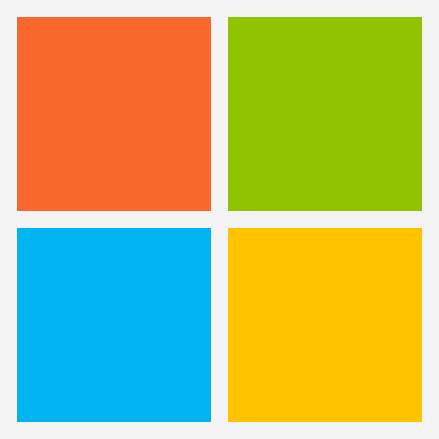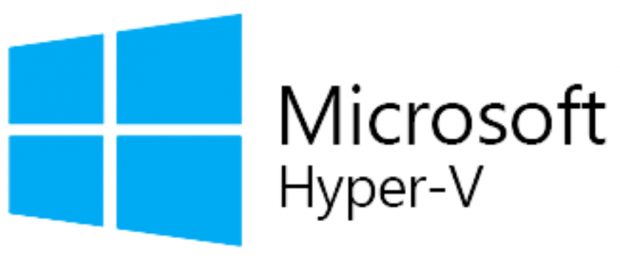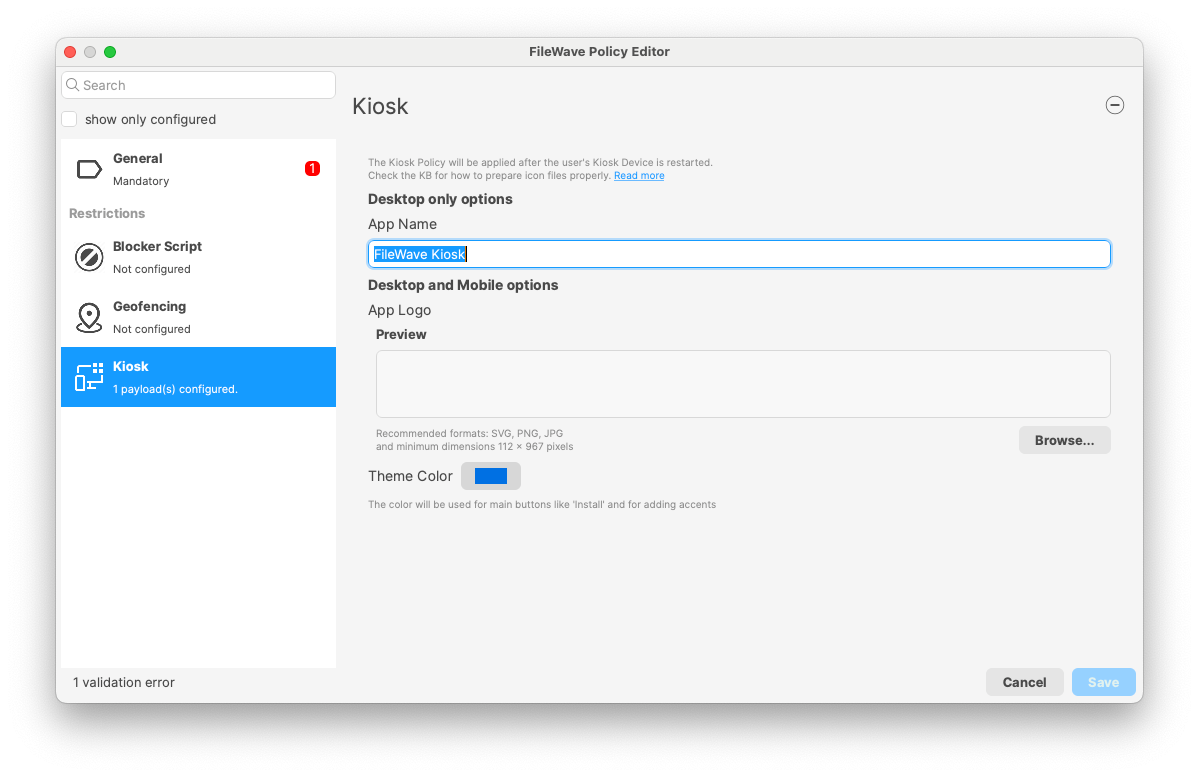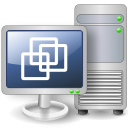FileWave Version 16.1.0
The FileWave endpoint management suite allows you to manage your devices wherever they are, wherever you are, whatever they are, and all in one platform!
In the 16.1.0 release we are thrilled to announce a significant upgrade to the FileWave Management Suite, featuring ...
FileWave database engine has been upgraded to Postgres 17 to benefit from security fixes and performance improvements.
If your current FileWave version is 15.5 or below, the Database upgrade process which will take place when updating to FileWave 16.1 can take more time than usual, depending on the size of your set-up.
Please make sure to plan accordingly for your upgrade to take a bit longer.
FileWave Official Version Support
FileWave supports the two latest major versions at any time. For example, if the current version is 16.1.0, we support versions 16.1.0 and 16.0.x. Major releases occur roughly every quarter.
What does “officially support” mean?
We will investigate and patch significant issues in these versions. We do not produce patches for versions older than N-1, focusing instead on current versions and future improvements. If an issue is found in an older version, remediation will be in the form of an upgrade or a patch to a more recent version.
You can still contact our support teams about earlier versions. They will assist you to the best of their ability but won’t escalate tickets to our development teams. Upgrading is recommended to access the latest features and bug fixes.
Compatibility
A Note on Compatibility
A note on the Compatibility charts: There are several states of compatibility for FileWave clients:
- "Fully Tested by QA" indicates that we have run QA regression tests against these operating system versions, and they are fully supported.
- "Expected to Work" Not being on the fully tested by QA list (such as macOS 12) does not mean that platform is not supported...it just means we did not actively test against it, but we do expect it to function. Support of any issues experienced specifically on these platforms would be considered on a case-by-case basis (but these cases are exceedingly rare.)
- "Legacy" versions mean that we don't test, but we do provide a retro-version of a client so that the device can still report in but as FW Server changes there may be challenges to these working. There is NO support for these platforms beyond the availability of the older client, and in almost all cases these are for OSes that are no longer supported by the OS vendor in question.
- Lastly, items do fall out of support, such as Windows XP and the older Android APK client as examples, but we always include these items in our release notes.
An additional note on third-party software inclusion, such as TeamViewer:
- Partnerships we have with third party providers have their own set of system requirements for those released applications. We test against their most recent versions, and support of those applications is limited to third-party vendor specifications.
FileWave Server Platform Support
- macOS 14, 15 (Intel and Apple Silicon)
- Debian 12.10 x86_64 (Note that any Debian 12.x is expected to work, and applying security updates may move you to a higher version.)
Expected to work
- macOS 12, 13 (Intel and Apple Silicon)
Virtual Appliances
- HyperV - The images are available as Generation 1 or Generation 2
- VMWare ESX - The images require vmx-19 support which means VMWare vCenter 7.0 Update 2 is the minimum version. ( https://knowledge.broadcom.com/external/article?legacyId=2007240 )
- VMWare Fusion
- VMWare Player and Workstation
- VirtualBox
Your existing FileWave Server must be version 13.3.1 or higher before you can upgrade to FileWave 14.7.2 and then from 14.7.2 you can upgrade to 16.1.0. The minimum memory requirement for FileWave Server is 8GB.
FileWave Clients Platform Support
All OS must be 64bit.
Fully Tested by QA
- macOS 14, 15 (Intel and Apple Silicon)
- Windows 10 (Ent/Pro 21H1 and above), 11 (Ent/Pro 21H2 and above) - x64 architecture.
Expected to work
- Windows Server 2022, Windows Server 2025 - x64 architecture.
- Windows 10 (Edu 21H1 and above), 11 (Edu 21H2 and above) - x64 architecture.
- macOS 12, 13 (Intel and Apple Silicon)
Legacy
- macOS 10.11 → Legacy Version 13.1.5
- macOS 10.12 → Legacy Version 14.0.2
- macOS 10.13 → Legacy Version 14.5.4
- macOS 10.14 → Legacy Version 14.8.0
- macOS 10.15 → Legacy Version 15.0.1
FileWave Mobile Clients Platform Support
- iOS 17.6, 18
- iPadOS 17.6, 18
- tvOS 17.6, 18
- Android 14, 15 (EMM Client)
- Chromebook
Expected to work
- iOS 14, 15, 16
- iPadOS 14, 15, 16
- tvOS 14, 15, 16
- Android 8 to 13 (EMM Client)
Legacy
- iOS 13 → Legacy Version 15.0.1
- iOS 10, 11, 12 → Legacy Version 13.1.5
FileWave Central (Native) Platform Support
All OS must be 64bit.
Fully Tested by QA
- macOS 14, 15 (Intel and Apple Silicon)
- Windows 10 (Ent/Pro 21H1 and above), 11 (Ent/Pro 21H2 and above) - x64 architecture.
Expected to work
- Windows 10 (Edu 21H1 and above), 11 (Edu 21H2 and above) - x64 architecture.
- macOS 12, 13 (Intel and Apple Silicon)
FileWave Booster Platform Support
All OS must be 64bit.
Fully Tested by QA
- Debian 12.10 x86_64 (Note that any Debian 12.x is expected to work, and applying security updates may move you to a higher version.)
- macOS 14, 15 (Intel and Apple Silicon)
- Windows 10 (Ent/Pro 21H1 and above), 11 (Ent/Pro 21H2 and above) - x64 architecture.
Expected to Work
- Windows 10 (Edu 21H1 and above), 11 (Edu 21H2 and above) - x64 architecture.
- Windows Server 2022, Windows Server 2025 - x64 architecture.
Virtual Appliances
- HyperV - The images are available as Generation 1 or Generation 2
- VMWare ESX - The images require vmx-19 support which means VMWare vCenter 7.0 Update 2 is the minimum version. ( https://knowledge.broadcom.com/external/article?legacyId=2007240 )
- VMWare Fusion
- VMWare Player and Workstation
- VirtualBox
FileWave Imaging Virtual Server Platform Support
The FileWave Imaging Virtual Server (IVS) is a special appliance that provides imaging support for Windows 10 and 11 UEFI and non-UEFI devices.
Virtual Appliances
- HyperV - The images are available as Generation 1 or Generation 2
- VMWare ESX - The images require vmx-19 support which means VMWare vCenter 7.0 Update 2 is the minimum version. ( https://knowledge.broadcom.com/external/article?legacyId=2007240 )
- VMWare Fusion
- VMWare Player and Workstation
- VirtualBox
Features and Updates in this Release
FileWave Management Suite Changes
Improved Fileset delivery for Cloud-hosted servers
With FileWave 16.1, we are introducing a new way to store and deliver filesets, based on modern and secure industry standards. For hosted instances, filesets will now be stored on private CDN, only available for your devices. This combined with revisited fileset download mechanism will greatly improve fileset delivery and end-user experience.
Fileset download, for cloud-hosted servers, will use https, both for complete fileset or single file delivery ; FileWave Boosters 16.1 are capable of caching https requests from clients to speed up even further delivery and helping you managing better your network infrastructure. Booster Monitor has been extended to show usage of https cache.
Delivery mechanism for on-prem servers remains the same.
Content Pack (Central)
Like Anywhere, FileWave Central is now showing in Client Info the list of installed applications for Desktop (Windows and non-MDM macOS devices)
Installed Application list for desktop devices (Central)
A very useful FileWave Anywhere feature is coming to FileWave Central; In Client Information, each fileset status can now list all associations which could lead to the deployment of the Fileset.
Unified Fileset Reports (Central)
For historical reasons, FileWave had a different presentation for Desktop Fileset reports and for iOS / Mobile fileset reports. FileWave Central 16.1 unifies both reports for a simpler user experience.
User Interface Enhancements
- Double-clicking a device in any list with a "Client Info" context menu option will now open the client information.
- Devices in the "Awaiting Configuration" state are highlighted with a different color for easier identification.
- The Fileset view includes new context menu options: "Show Content" (if applicable) and "Fileset Report."
Localization Improvements
-
- Japanese translations are now available as long as the regional language is set to Japanese, without requiring the country to be set to Japan.
Winget and Autopkg Enhancements
-
- The Winget Search dialog features tooltips for descriptions and a context menu that links to the package home page, if available.
- The Autopkg Search dialog now displays all packages by default, instead of showing an empty list.
Apple-Specific Changes
Apple Spring release 2025 support
New DEP Skip Key
- New DEP Skip Key (“Safety and Handling”) and corresponding Setup Assistant item
Updated profiles
- Extensible SSO has a new setting to include UDID and Serial Number into Platform SSO attestations
- Managed Relays can now match or exclude FQDNs
- New Restrictions:
- MDM can disable Apple Intelligence reports with the allowAppleIntelligenceReport restriction.
- MDM can disable smart replies in Mail with the allowMailSmartReplies restriction.
- MDM can disable the ability to summarize content in Safari with the allowSafariSummary restriction.
- MDM can control whether the default calling app can be modified using the allowDefaultCallingAppModification key.
- MDM can control whether the default messaging app can be modified using the new allowDefaultMessagingAppModification key.
- VPN profile updated against updated documentation (Authentication Name, Password and Remote Address changes)
- WebClip can use different url schemes like mailto
- XSan now has “SAN configuration URLs”
Allow Idle Reboot
New setting (available as Command Policy Profile) to allow devices to automatically reboot while locked after several days of inactivity.
Battery-health status on iPadOS
Battery-health status is also reported by compatible iPads
tvOS Software Update now uses DDM
tvOS was not capable of using DDM to enforce software update - this is now the case with tvOS 18.4
Beta Software Update Setting (DDM configuration)
it is now possible to configure how your devices can apply to different beta programs your organization signed up for.
Application management using DDM
Application management was possible with DDM, but without App Configuration support ; this is now possible, starting with iOS 18.5.
App configuration can be defined either directly within Fileset Properties or with a DDM Asset ; FileWave will automatically convert the asset into MDM App config if the fileset is deployed to devices not supporting DDM App installation.
FileWave 16.1 also brings support of iOS 18.5 feature allowing applications to use specific DDM assets (certificates, identity...).
DDM Information in Client information
DDM Declaration is now showing more details in DDM-capable Client Information dialog:
- it shows the expected declaration (based on the current model) together with the applied declaration (which has been sent to the device).
- it shows the content of the configurations applied to the device.
Beta Program at enrollment
The same way you can enforce devices to be at a given OS version at enrollment time, you can now enforce a specific Beta version in DEP profile, if your organization applied for the corresponding beta program.
DDM asset and configuration editor
Updated all descriptions with Apple’s updated documentation
MDM Lock dialog
Dialogs have been modified to clarify the feature works differently on macOS and on iOS.
Internals
As installing profiles on macOS can’t be done locally using fwcld anymore (only using MDM), fwcld is not downloading profile content anymore, reducing resource requirements.
DDM Assets are now more versatile, and are not stored in database anymore (only on disk, reducing resource requirements.
Android-Specific Changes
Policy changes
MAC Address randomizer setting is now available in Network policy.
FileWave Windows Imaging (IVS) Changes
FileWave Windows Imaging solution relies on PXE Boot, which delivers a tiny Linux image containing all required components to run the imaging process. Compatibility with different hardware depends on how the tiny linux image is built - mainly which Linux kernel version and embedded packages and modules.
FileWave Networking Imaging 16.1.0 brings compatibility with FileWave 16.1.x.
- Linux Kernel: 6.13.10
- Buildroot: 2025.02
FileWave Kiosk Changes
Kiosk customization as FileWave Policy (Central/Anywhere)
Kiosk customizations are now integrated as FileWave Policy, allowing simplified group deployment.
Removal of Legacy Kiosk UI
-
The old Kiosk UI has been removed from Mac and Windows clients after three stable releases of the new Kiosk UI.
-
Geolocation functionality remains unchanged.
-
Reboot modals continue to function on both Mac and Windows in the old style.
-
TeamViewer sessions are unaffected and continue to work on both Mac and Windows platforms.
-
Note: This update eliminates duplicate tray icons by removing the old
fwGUItray icon.
New "Missing Device" Message in Kiosk for macOS and Windows
-
When a macOS or Windows client is marked as “Missing” in FileWave Admin, a “Missing Device” message will now be displayed in the Kiosk, similar to the “Device Locked” message.
-
The “Missing Device” message will include any custom Lost Mode Message and Lost Mode Footnote set in Central Admin under Organization Info.
-
By default, if no custom message is set, the following message appears: “This device is currently marked as missing. Self-service Kiosk is not available. Please contact your administrator.”
-
Kiosk Restrictions: While in the "Missing" state, the Kiosk will prevent installation, uninstallation, and normal access to self-service options, similar to “Device Lock” functionality.
-
Additional Information:
-
If only the Lost Mode Message is set, it will display alone.
-
If only the Lost Mode Footnote is set, the default lost mode message will appear with the custom footnote.
-
If an organization contact number is set, it will be displayed as a clickable link for easy access.
-
Internal Changes
Third party libraries
Third-party libraries updated for improvements and security changes. Mainly:
- With FileWave 16.0, Postgres has been upgraded to 17
Upgrading Database engine requires upgrading Database data, which can take some time.
Be patient when upgrading to FileWave 16.1 from FileWave 15.5 or above. - Qt has been upgraded to 6.9
- Python has been upgraded to 3.13
- OpenSSL has been upgraded to 3.5.0
PG Bouncer
PgBouncer is a service that helps manage how applications connect to a PostgreSQL database. It keeps things running smoothly by reusing existing connections instead of creating new ones constantly, which improves speed and stability, and reduces resources requirements.
Deprecated Features
The following features have been deprecated from FileWave 16.1. They are present but will be removed in a future release:
- FileWave Central Dashboard: The Dashboard in FileWave Central will be replaced by a view of a Grafana Dashboard to not maintain 2 Dashboard systems.
- Client Monitor application: The standalone Client Monitor will be removed in a future release because it is only used for FileWave Clients < 16.1.0 as well as monitoring the IVS server. It will be included at least until the IVS dependency is removed.
We encourage you to provide product feedback if you have any concerns: FileWave Product Management or in the Help menu of Central/Anywhere you can send feedback as of 16.1.
Decommissioned Features
The following features have been removed from FileWave 16.1:
- macOS 10.11 El Capitan: Released in September 2015, this version of macOS will not work with even a legacy client due to an incompatibility with a current version of OpenSSL.
Security Notices
The following security notices are relevant to this release:
- Fixed vulnerability WITH-ZD-2025-0001, reported by Withsecure Exposure Management (https://www.withsecure.com/). In non-default custom configurations, FileWave Windows clients (v15.5.2 and earlier) allowed local, non-privileged users to escalate privileges to SYSTEM. This issue is resolved in FileWave v16.0.0; a CVE was issued of CVE-2025-43922 on April 20, 2025.
Changes and Fixes in 16.1.0
Changes and Fixes in 16.1.0
Bug fixes:
Changes and Fixes in 16.0.4
Bug fixes:
Included Open Source Software
Click here for the extensive list of Open Source Software included in the FileWave products.
Upgrading Your Environment
macOS Downloads

macOS Upgrade Fileset (md5: 4dcf5fc5a5b1cc9a6fbc77fef19bf30b)63f66244f065c5af621790f42e296c49)
macOS Admin (md5: 1d7671e5cf71f1f4edea464cee9d2126)1d3b0fcd642347490d1e60f21106b03e)
macOS Booster (md5: 7c4d5c650cd6b6a774dbf068751494c6)513f73bbb8c6a3dbde67a427b3d579d4)
macOS Server (md5: a2789e3ce2d73a75a4e49f8cd29b65dd)7366347401cc8da3cfcb306e6266bd44)
Remember that to upgrade macOS FileWave clients you should use the Upgrade Fileset. Never deploy the macOS Client installer from https://custom.filewave.com to an existing device. It is intended for new installs.
Windows Downloads

Windows Upgrade Fileset (md5: 21c9decc64f82b701cfabf934b092267)cfbcc0237ec6a72bcadc8b7a9a52f009)
Windows Admin (md5: f497347c28f004c138c26c420fa722b0)611b29515dc0eda85c8f4c0229f76f14)
Windows Booster (md5: 7fdb891de1f6310d303ef4b0f0baad65)cf557349608244f0896b124d3d598cd8)
Remember that to upgrade Windows FileWave clients you should use the Upgrade Fileset. Never deploy the Windows Client installer from https://custom.filewave.com to an existing device. It is intended for new installs.
Chrome Extension
 The FileWave Inventory extension for Chromebook has to be installed via the Google Admin Console for your domain. Please see Quickstart Guide for Chromebooks for detailed instructions
The FileWave Inventory extension for Chromebook has to be installed via the Google Admin Console for your domain. Please see Quickstart Guide for Chromebooks for detailed instructions
Debian Linux Downloads
Debian Linux Server (md5: 4b71730f02c0435cf777f2dfd0461880)4ab08423d79f9a41d29809425b601ad6)
Debian Linux Booster (md5: 0913d728553879f85de783e2968dbb52)1ecae0f4d7bf1d910367b142ab84a8ad)
Debian Linux IVS: FileWave Admin (md5: 68af3ab203541da04fe07083594051be)b9fb447bf772f7429821229cb3b90c5c)
Debian Linux IVS: FileWave Imaging Client (md5: cd20350ec43a036c38c142d9e0d0a733)273a54318d5213830175608adc99c330))
Debian Linux IVS: IVS Kernel (md5: a8964bf201ea7cd3a44f1eef035263b5)35e6e14029edb3ec5a5fc356c3c312cf)
Debian Linux IVS: FileWave IVS (md5: {{ debian_ivs_deb_md5 }})
For any of the below upgrades you would want to console or SSH to your Server/Booster/IVS and then run the command listed to upgrade the relevant component.
If you are using a FileWave appliance that before 15.4.0 the SSH access was with the user "root" and for any appliance setup from 15.4.0 or later the user is "fwadmin" and you would have been forced to set the password on first login.
Upgrading the FileWave Server
To install or upgrade the FileWave Server, use the following :
wget -qO- https://kb.filewave.com/attachments/411 | sudo bash -s -- -v 16.1.0 -r 1 -p -yUpgrading a Booster
To install or upgrade the FileWave Booster, use the following or Booster Auto-Upgrade :
wget -qO- https://kb.filewave.com/attachments/412 | sudo bash -s -- -v 16.1.0 -r 1 -p -yUpgrading a IVS
To upgrade the FileWave IVS, use the following:
wget -qO- https://kb.filewave.com/attachments/408 | sudo bash -s -- -v 16.1.0 -r 1 -p -yVirtual Appliance Downloads
OVA Images
These three images are OVA images suitable for VMWare or other systems that use OVAs:
VMware and VirtualBox (OVA) Server Appliance (md5: c5c3d4207aa4cb5df93faa794205d3f8)ae0a1c64eb40bc0d590a4e1e849d5d0a)
VMware and VirtualBox (OVA) Booster Appliance (md5: d041c7cebf36bcf98e0b2b5e32d1ba8d)6dbf5e89574934cf439671a6b2229f4c)
VMware and VirtualBox (OVA) Imaging Appliance (md5: 524201282c251168465cb0aac117923e)fb896c8814a348731d171382cc6b0172)
 HyperV Images
HyperV Images
These three images are Hyper-V images suitable for Microsoft Hyper-V (Gen 1):
Hyper-V (VHD) Server Appliance (md5: edacef9ad3d58d9c11af2201350310d8)f8929c94b4ede23985036d27969c52aa)
Hyper-V (VHD) Booster Appliance (md5: e86f72fc610213c5148a3e092ec73274)123c354ac2ad2532e3c30a42ead62b13)
Hyper-V (VHD) Imaging Appliance (md5: 1975368d8de647ab91395b6cf1ea2744)256c39050bb62e07820858906b65709d)
These three images are Hyper-V images suitable for Microsoft Hyper-V (Gen 2):
Hyper-V (VHD) Server Appliance (md5: 80057cccb319897e032d56d7bb315000)c1b8db2d662ef9686bdf0dce9d3d5833)
Hyper-V (VHD) Booster Appliance (md5: 205a4c7808da258ca6519d5476eb7339)0f467033c9c2bc121011d0b116b4faf4)
Hyper-V (VHD) Imaging Appliance (md5: 2a105851fff82a8f073f70d5dbfe4111)519fb944466042790d47c00268a75221)
To get started with the FileWave Server appliance please see: 1. Installation and Setup | FileWave KB
For a Booster you would setup networking just like you do with Server and then: Booster Installation | FileWave KB
For more information about importing the IVS appliance please see: Importing FileWave Appliances
CentOS is EOL. You must Migrating your On-Premise FileWave Server to new Hardware to get to FileWave on Debian or consider our Cloud Hosting Product.
Unconfigured Client Installers
macOS and Windows
Please note that the below is only to be used when Support has identified that they are needed to fix an issue. Normally these Client packages are not used. Pushing the PKG or MSI below from FileWave can break a client.
macOS Client (md5: 73c4eecc9702a4c1d5f8fe6c10eacd3e)f7880fa96970872c58dfba45e6ae5ac6)
Windows Client (md5: de2067eabb16c92adf0c119fb37a3d22)8a6600273c1a3ee53e7fb296b0d2daeb)




